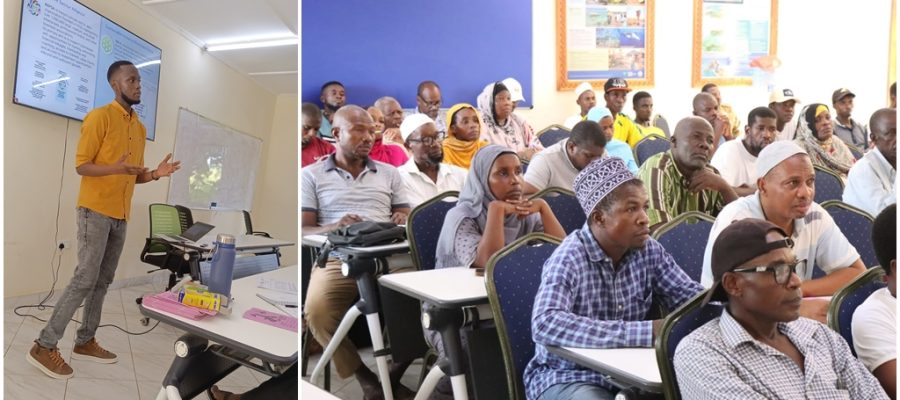The interconnected nature of native communities with their land and livelihood activities is undeniable when one looks at how they rely on environmental observation in daily decision-making. With little to no help from technology, they observe seemingly unrelated occurrences, such as the behavior of animals and insects, and then form a climatic prediction. Similarly, they naturally practice sustainable methods of farming and sourcing food and display adaptation and mitigation methods in their lifestyle.
Most seasoned members of native African communities will agree that the sighting of frogs at the ponds loudly croaking, active ants transporting food scraps back to their anthills, and the sighting of numerous black swallows, signifies rainfall is coming. At least, this is according to the indigenous people of my village, who would start preparing buckets to collect rainwater, and preparing their land for planting.
The merit of their predictions lies in their livelihood-dependent, urgent need for accuracy. Their predictions give a green light to significant activities such as preparing large lands for farming and for pastoralists, migrating to another area entirely. Given that the natives confidently depend on their natural knowledge to make decisions that alter the course of their livelihoods, shouldn’t they be included in the climate action conversations by policymakers?
The Kenya National Climate Change Action Plan (NCCAP 2018–2022) states that by 2030, we should have reduced greenhouse gases by 30%, mainstreamed climate change adaptation into the government’s planning processes, and implemented adaptation actions. The main objectives of the document are to provide mechanisms and measures to achieve low-carbon climate-resilient development and enhance climate resilience for vulnerable groups. Priority areas include disaster risk management, food and nutrition security, water and the Blue Economy, forestry, wildlife and tourism, health, sanitation, human settlements, manufacturing, and energy and transport.
Native communities already have naturally sustainable practices for most of the key areas mentioned above. Their input in climate action can help us achieve these goals harmoniously. How can their knowledge be combined with relevant scientific findings and used to reinforce policymakers’ decisions?
In an effort to explore this question, I talked to the Kenya Private Sector Alliance’s (KEPSA) Senior Circular Economy and Climate Change Coordinator, Dr. Jackson Koimbori, to get his perspective.
Dr. Koimbori worked on a project in South Sudan that assessed the interplay and conflict between climate change and natural resources. According to him, indigenous knowledge carries merit and can contribute to solutions in climate action. “My role in the project in South Sudan was to establish the causes of conflict and how climate change plays a role in resource-based conflict,” he said. “In our recommendations, we highlighted the need for indigenous knowledge to reduce the effects of climate change on natural resources,” added Dr. Koimbori.
Native communities also prove that we naturally have sustainability practices ingrained in us when it comes to food and resource management. The biology scholar mentioned that he observed indigenous methods of mitigation and adaptation that could contribute to climate action. “Indigenous communities in various regions practice agroforestry, combining trees with crops to enhance soil fertility, conserve water, and sequester carbon,” said Dr. Koimbori.
He added that the native community he worked with also demonstrated safety and sustainable fishing practices. “Additionally, traditional fire management techniques, like controlled burns, help maintain ecosystem health. Furthermore, indigenous knowledge systems inform sustainable fishing practices that ensure the resilience of aquatic ecosystems amidst climate impacts.” One quality that stands out in the natives’ practices is their moderation when using resources and mindful restoration techniques.
When it comes to climate action, policymakers should appreciate the need to include native communities in the discussion. Integrating indigenous peoples’ knowledge into formal climate action strategies not only enhances their effectiveness but also promotes environmental justice and cultural preservation. “It is crucial to engage indigenous communities as active partners in decision-making processes, respecting their rights, traditional governance systems, and land tenure arrangements,” said Dr. Koimbori. Adding on the importance of observing the native communities’ existing structures and knowledge, he continued, “Moreover, acknowledging and valuing indigenous knowledge systems can foster social cohesion and empower marginalized communities to take ownership of climate resilience efforts.”
Native communities in Kenya and Africa can set a good example for city residents in cutting down on consumption and waste. Taking what is just enough for us can contribute to a healthier environment and stable food production, reducing the 40% of food lost in Kenya annually in the journey from the farm to our dinner tables, according to a Food & Agriculture Organization (FAO) report.
In conclusion, policymakers must prioritize inclusive approaches that bridge traditional and scientific knowledge systems, facilitating meaningful dialogue and collaboration. By recognizing and incorporating these indigenous approaches into climate policies and adaptation strategies, we can promote ecological resilience, safeguard cultural heritage, and advance climate justice on a global scale. Additionally, investing in capacity-building and knowledge exchange programs that empower indigenous people to actively participate in climate action initiatives is essential for long-term success. Ultimately, integrating indigenous knowledge into formal climate action strategies is not only a matter of environmental sustainability but also of social equity and cultural respect.
By Absalom Mulama, Communications Assistant at KEPSA, for Sustainable Inclusive Business-Kenya (SIB-K).



